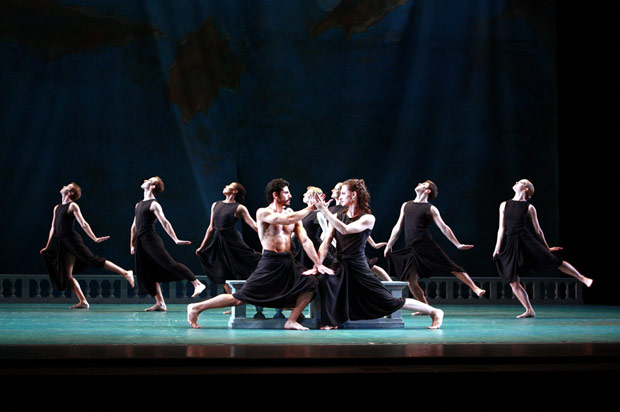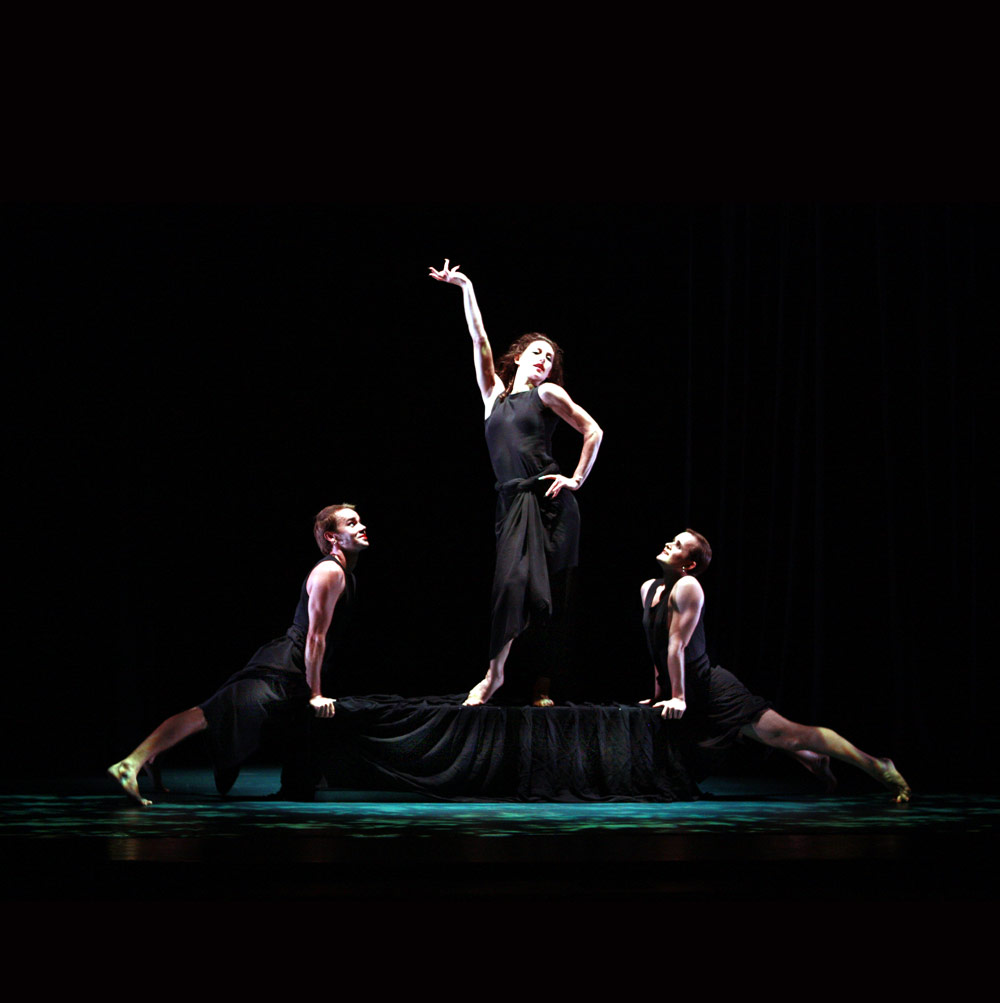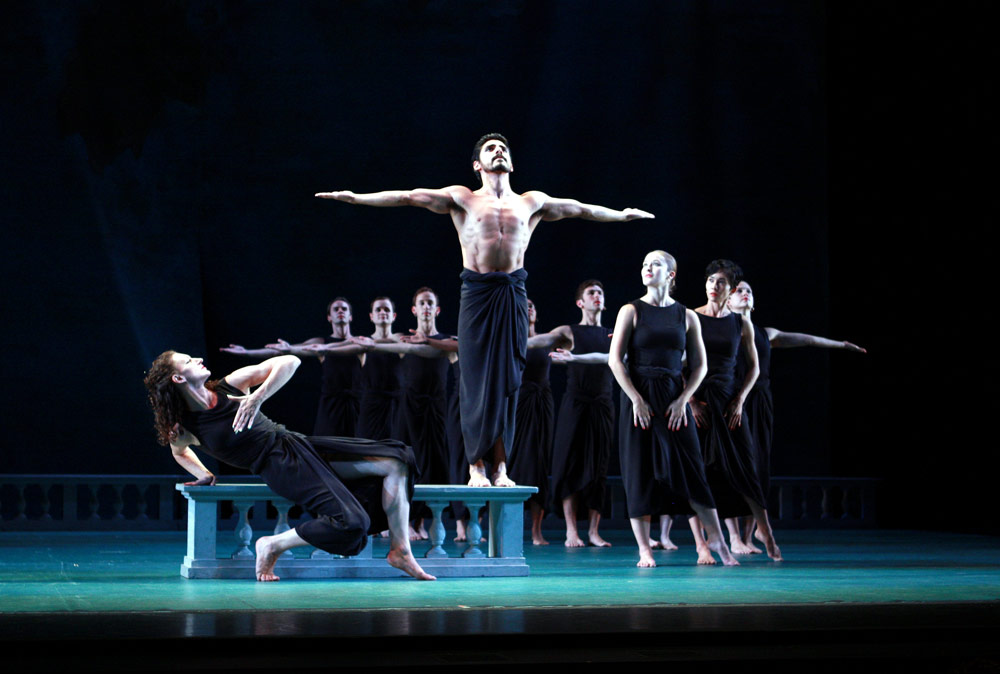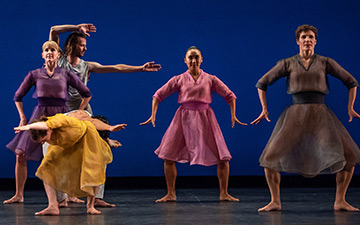
© COSTAS. (Click image for larger version)
How Can So Hard a Fate Be Took?
Mark Morris Dance Group
Dido and Aeneas (part of Mostly Mozart Festival)
New York, Rose Theater
23 August 2012
markmorrisdancegroup.org
Mark Morris created his version of Dido and Aeneas in 1989, when he was the choreographer in residence at la Monnaie, in Brussels. It was a difficult time in his career – his works were often disparaged, even ridiculed, by the local press, and audiences never really took to his irreverent attitude, or to his self-consciously “plain” style of movement. He was far from home, and feeling panicky because of the escalating AIDS epidemic, a horrifying scourge that was taking many of his friends. As he recently told Joan Acocella (video link or see below), “I assumed that I was next.” His way of responding was to make a dance using Purcell’s opera, about a Queen who is forsaken by her lover and dies of a broken heart. As he told Acocella, he thought: “before I die, let me make up this dance about love and sex and death.”
Of course one needn’t know all this to enjoy Morris’s Dido (currently at the Rose Theatre as part of the Mostly Mozart Festival). But, at least for me, it did illuminate something about the work’s startling power. Because, for all its stylishness and the tautness of its construction – and it is one of the most economical works I know – what lingers in the mind is a sense of urgency. Morris’s Dido is not just about the sexual longings of the Queen of Carthage, it’s about Mark Morris. In making it, the choreographer fully identified with her plight, but also with wild, destructive tendencies of her alter-ego, the Sorceress. This was even more self-evident when Morris performed both roles, as he did for over a decade. He explained to Acocella that initially, he had envisioned the whole thing as a solo in which he alone would play all the roles (including Aeneas), without the support of an ensemble or secondary characters.
Morris no longer dances much (though he played Dr. Stahlbaum in The Hard Nut last Christmas), so the ballet has now been passed on to dancers in his company. The usual story. (Morris has now taken up conducting.) In 2006, the two characters were split between Amber Star Merkens (as Dido) and Bradon McDonald, who made a wonderfully petulant, flame-haired Sorceress. Subsequently, McDonald danced both roles (a combination which I’m sorry to have missed). McDonald has now retired, so it is the tall, majestic Amber Star Merkens who has now taken on this two-headed monster of a role. No dancer will ever perform it with Morris’s sense of campy drama (captured for eternity on DVD, for anyone interested, and also on YouTube – see below). But instead of trying to re-capture Morris’s inimitable performance style, Merkens has subtly remade the role in her own image. She is less wild than either Morris or McDonald. But in her commanding, impeccably dignified interpretation, the ambiguity of gender that lies at the heart of the work is clearly delineated, without an ounce of excess.
With her long, angular features – like those of a Byzantine princeling – and her powerful, sinewy build, Merkens hovers between male and female in a way that constantly tricks the eye and the heart. (It should also be said that she is startlingly beautiful, like an icon.) It is when she plays the swaggering Sorceress that she appears most “female,” in a monstrous sort of way, like an old hag showing too much leg. As she vamps atop a black bench, the only set, raising one arm overhead while seductively leaning into her opposite hip, daring you to come onto her, she suddenly takes on the allure of Marilyn Monroe. Or perhaps the drag-queen version of Marilyn. Her Dido is so stripped down that it defies gender. She is a Queen, a symbol, a tower of dignity seen mostly in profile, palms out, legs bent to form a geometric wedge. Merkens does not try to impose her own personality on either role; instead, she listens to the music and the words, her interpretation rising straight from the text. As she told Gia Kourlas in an interview for TimeOut: “It almost feels like the music is coming up through me.” (“Aamber Star Merkens talks about the Mark Morris Dance Group”). It is a testament to the work’s essential rigor that even in Merkens’ austere interpretation, its pathos comes through loud and clear.

© COSTAS. (Click image for larger version)
In Purcell’s Dido, Morris found not just the right story, but also the perfect musical counterpoint for his choreography. Purcell’s “plain,” unembellished style (along with Nahum Tate’s poetic libretto) is direct without tipping into emotional or stylistic effluences. The call-and-response of the soloist voices and chorus is easily translatable into dance terms, as are the shifting moods from one scene to the next. Purcell’s lapidary portrait of Dido alternates with passages of lightness (especially for Dido’s friend Belinda and the Second Woman) and humor (as in the sailors’ mocking farewell to their sweethearts). Then there is the gleeful mayhem of the Sorceress’s coven (inspired by the witches in Macbeth). The repetitions in the music and libretto allow Morris to create patterns that imprint themselves on the eye, a lattice of leitmotifs that becomes its own language.
Morris has matched Purcell’s idiom with a spare, emphatic style that combines meaningful gesture (the releasing of an arrow, say) with a bit of plain mime, a smattering of campy spectacle (the witches do something that resembles vogueing), satisfying group dances, and exciting syncopated percussion of the feet. (There is also quite a bit of slapping of thighs, tables, feet.) The gestures can be illustrative, as when the witches cut each other from groin to neck, again and again. Or they can be more abstract, like the “fate” gesture repeated by Dido, then by Aeneas, and finally by the court: open arms, chest forward, fingers splayed. As in Indian dance, the fingers are particularly lively. Sometimes, Morris uses everything at once, as in the dance for the so-called Second Woman, performed with quiet panache by Rita Donohue: her feet lay down a percussive bass, while her torso folds and twists with the melody, and her hands depict fragments of the story of Diana and Actaeon, reflecting the libretto. At the high point of her dance, she tears at her chest, illustrating Actaeon’s fate. Then, when the chorus comes in, her dance is taken up by the ensemble. Now all the dancers keep time with their feet, sway their torsos, and tear at their breasts. Dido and Aeneas watch impassively, their erect backs toward the audience. The idea is simple, but the means by which it is accomplished is not. The effect is an exultation of the eye and ear. The dance needs no interpretation, it simply is.
Now that Morris has taken to conducting, the unity of musical intention is even more complete. Morris may not be the kind of conductor who makes you hear the music anew, but he does know what he wants from the orchestra, especially in the matter of tempi. Recently, he told Nancy Dalva (in the Brooklyn Rail) that he sees his job as conductor as “lay[ing] the beat down – secure and true.” (“Mark Morris with Nancy Dalva”). This he does impeccably. Purcell’s music in Dido is not particularly intricate, so what is needed here is someone to set the right mood, create dynamic contrasts, and provide a pulse that keeps the music and dancing alive. All this was accomplished, with help from an excellent orchestral ensemble, chorus, and quintet of soloists. The mezzo Stephanie Blythe sang both Dido and the Sorceress. The Trinity Choir created a lovely, relaxed, well-blended sound, as did the musicians of the MMDG Music Ensemble, playing period instruments. Blythe, known for her creamy, powerful voice in roles that range from Gluck’s Orfeo to Fricka in the Ring and the outrageous Zita in Gianni Schicchi, reined herself in here to produce a consciously “early-music” sound (with little vibrato). Her portrait of Dido was intimate but not particularly emotional, and her characterization of the witch, cheerfully wicked. I was particularly taken with the fresh, blossom-like voice of the soprano singing the role of Belinda, Yulia Van Doren.

© COSTAS. (Click image for larger version)
The entire company performed well. Domingo Estrada Jr. brought just the right note of beefy heroism to the role of Aeneas, a character who knows only two things: lust and duty. Rita Donohue imbued the role of the Second Woman with her usual gentleness and sense of joy. Lauren Grant, recently back from pregnancy leave, was a lusty, lightfooted sailor. Noah Vinson and Dallas McMurray camped it up as the Sorceress’s two sidekicks, but could probably give their roles a little more bite. Best of all, to me, was Maile Okamura, as Belinda. I had never realized what an important part this character plays. Belinda is Dido’s friend and confidant; she is the moon to Dido’s sun, ever-aware of her mistress’s changing mood. In the end, it she who stays by the Queen’s prone body when all the others have departed. Okamura’s Belinda was the essence of simplicity: she danced luminously, quietly, attentively. This is the one role that I cannot imagine being danced by a man – her delicacy is the essence of femininity. I had never realized it, but the real hero of Morris’s Dido is Belinda.
It is something of a cliché to say it, but the guiding principle of Morris’s Dido – as in the more recent Socrates – is simplicity. No single element – music, words, dance – is privileged above the others. One is constantly surprised by the rightness of a particular image or step: the little shuffling walk on high relevé during the overture, or the Sorceress’s gorilla-like run across the back of the stage. Or the way Aeneas pauses for an extra moment before disappearing behind the beautiful backdrop (by Robert Bordo); like a mirage, he is still there, but he’s already gone. How did it occur to Morris to choose this or that step at any particular moment? It’s the secret of great choreography, there’s no explaining it.

















You must be logged in to post a comment.